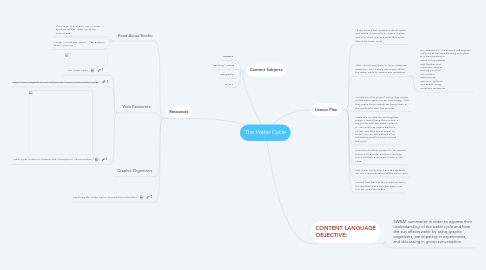The Water Cycle
by Payton Jones


1. Content Subjects
1.1. Science
1.2. Reading/ Writing
1.3. Geography
1.4. STEM
2. Resources
2.1. Read Aloud Books:
2.1.1. The Magic School Bus Wet All Over: A Book about the Water Cycle, by Patricia Relf
2.1.2. A Drop Around the World, by Barbara Shaw McKinney
2.2. Web Resources:
2.2.1. The Water Cycle
2.2.2. https://www.natgeokids.com/uk/discover/science/nature/water-cycle/
2.2.3. Water cycle | National Oceanic and Atmospheric Administration
2.3. Graphic Organizers
2.4. Exploring the Water Cycle | Precipitation Education
3. Lesson Plan
3.1. I'll ask them a few questions about water and where it comes from, where it goes, and how old it is to see what they know about the water cycle.
3.2. After introducing them to these awesome resources, we'll have a discussion about the water cycle to answer any questions.
3.2.1. ELL Standard 2: The student will express orally his or her own thinking and ideas. B-4: participating in social conversations with familiar and unfamiliar people; sharing personal information, experiences, opinions, abilities, and needs using complete sentences.
